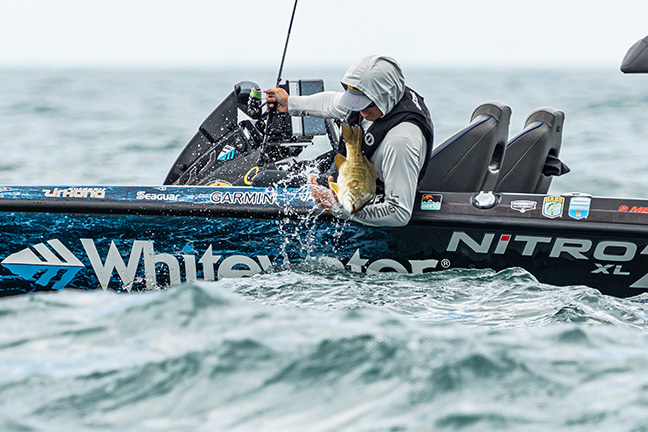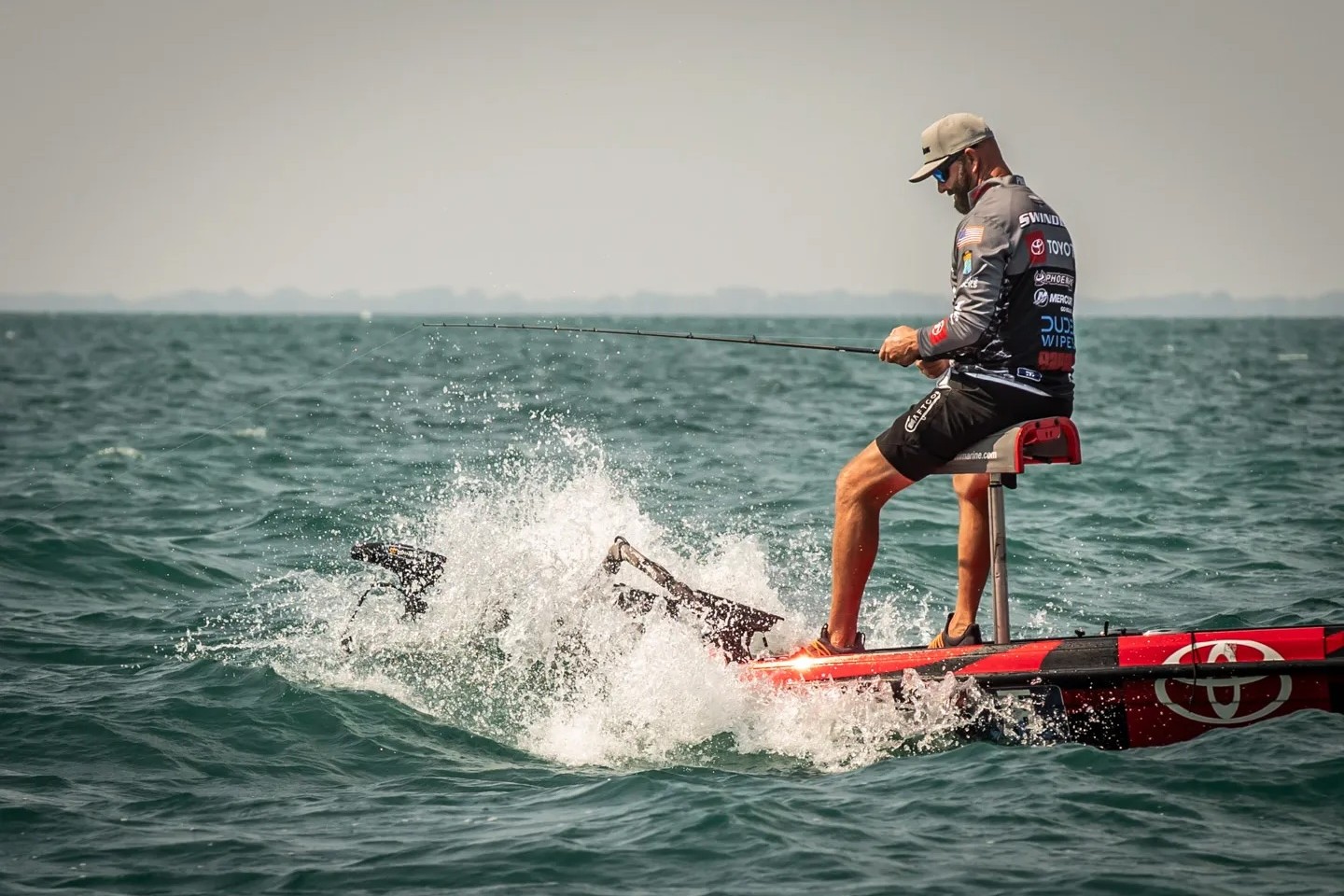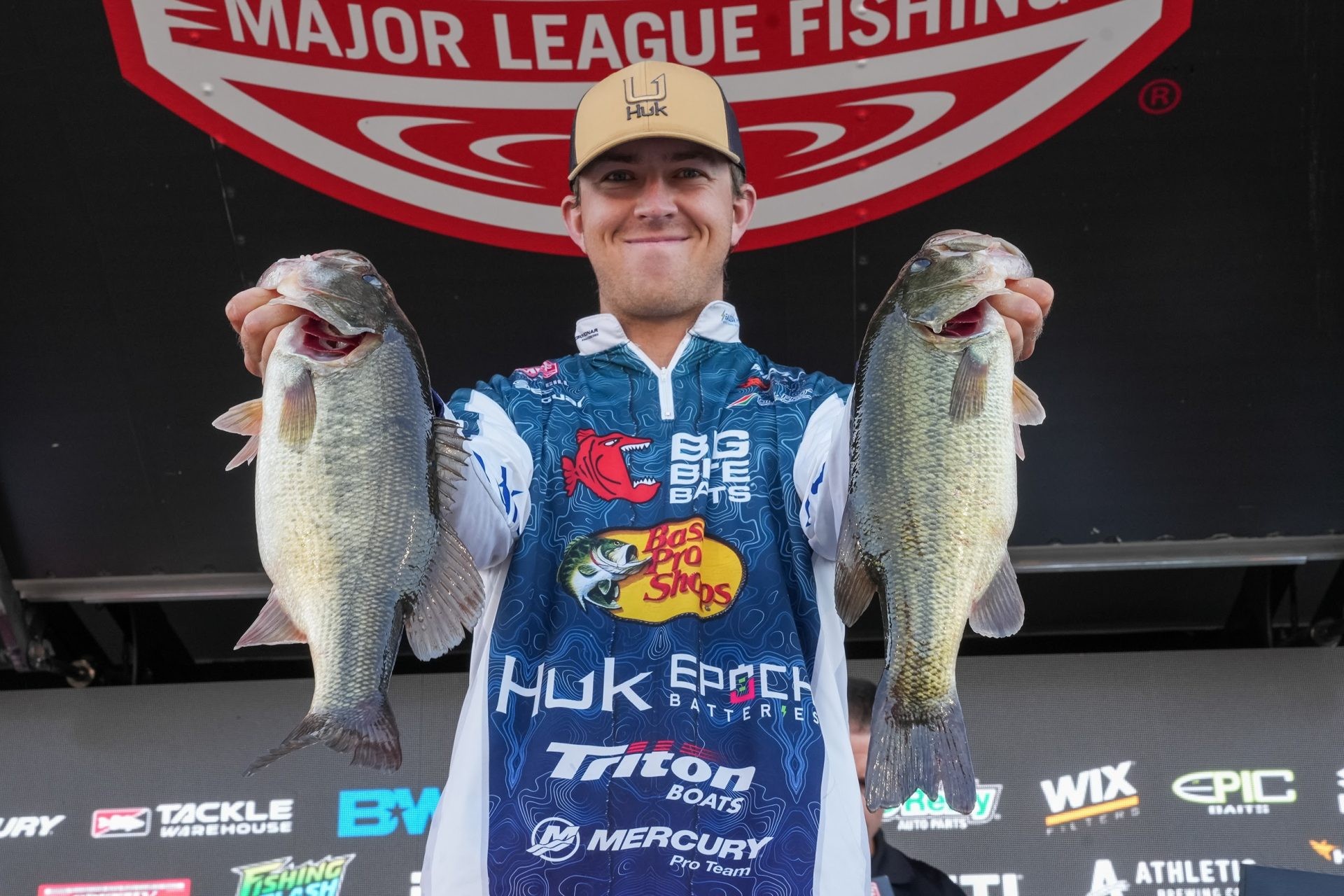Top Fall Bass Fishing Tips
|
WHITEWATER® pro staffer B.A.S.S. Elite angler, Jay Przekurat, talks tactics and tech for more bass this coming fall season. |
|
By Jim Edlund |
|
MUSKEGON, Mich. (September 7, 2023) – The last hurrah has faded into another marked-up calendar. Lakes, rivers, and reservoirs have quieted down. The party barges and annoying personal watercraft are gone, a Natty Light box the only remnants of another raucous Labor Day. Good thing, too, there’s nothing like trying to fish during party-time, every primary and secondary point, sandbar, and island anchored up with a bunch of Kenny Powers look-alikes blasting Motley Crew and “Baby Got Back” from hot-rodded, marine-rigged stereos, tattooed cousins and girlfriends/wives slurping ungodly, boozy concoctions out of giant travel glasses with bendy straws. With summer over and cooler temps finally in the forecast, now is the time to start talking fall bass patterns. That said, we gave B.A.S.S. Elite WHITEWATER pro, Jay Przekurat, a call. He’s always a wealth of green fish information. The youngest pro bass angler to ever win a B.A.S.S. Elite event, 23-year-old Wisconsin-based Jay Przekurat took home top honors in 2022 with the heaviest bag of smallmouths ever weighed in a B.A.S.S. event. |
|
|
The Fall River Bass Bite “Come fall and the rivers start cooling off, typically marked by a few rainfalls and colder nights. It’s during this time that I like to say rivers ‘turnover’. The fish just start biting. They get into an active mood because they know winter is coming,” says the young Przekurat. “To prep for fall I get all my moving baits organized: topwaters, swim jigs, crankbaits, A-rigs—basically any moving, reaction-bite based bait. On rivers, late summer through winter is the best time to be on the water because fish know winter is coming and they put on the feedbag.” Besides moving baits that rock the upper two-thirds of the water column, Przekurat also makes sure he has plenty of baits to work bottom. As the water gets progressively colder, bass key into bottom-dwelling forage, so you can find Jay slinging a lot of Texas Rigged soft plastics and tubes, too. “On rivers, bass will focus on baitfish earlier in the fall and then transition to feeding on crawfish and other bottom critters. They get lazier as the water gets colder. That’s when I switch over from cranks, swim jigs, and all that to Texas Rigs and tubes,” notes Przekurat. |
|
|
Fish-Holding River Structure: Fall “The main deal is rock, but sand and wood holds a lot of bass, too. Current seams, obviously. And more than rock, which gets hit hard by lots of anglers, I like to find wood and sand. Bass will group up on sand, especially if there’s a current break around that’s holding food. Ideally, I want to find that straight riverbank with sand and wood. And that’s more so with smallies. You can find largies all the way from the creek mouths to the vary backs of the creek arms. I’m constantly looking for green vegetaition, like eelgrass and milfoil, wood, all that visual stuff. So, I’m generally flipping isolated cover for largemouths, whether it’s with a Texas Rig or swimming a jig.” In terms of specific locations, Jay spent his youth exploring the Wolf River and Mississippi River systems. “I really like Mississippi Pools 5, 5A, 7, and 9 for fishing river largemouths. 7 is probably the best for numbers, but you can put together a 20-pound bag together there, too. Fall Bass on Reservoirs Przekurat says a lot of anglers fish too shallow on reservoirs in autumn. “Look for fish grouping up offshore. You can find some largemouths shallow but the smallies especially will generally stay a little bit deeper.” That’s when Jay pulls out Alabama rigs, swimbaits, and tubes. Basically, you’re going to break out the tackle you used in the spring. Moving baits are key to catching fall bass in reservoirs, just like in rivers. Fish are starting to get active and starting to feed. Spinnerbaits and ChatterBaits can produce, too. And you’d be surprised, fall bass will rise to eat topwater plugs and buzzbaits, too, even if the water temps are in the high-50s to lower 60s.” Natural Lakes in Autumn For the most part, bass will return shallow in fall. They won’t be as shallow as they are on rivers, but you’ll still find ‘em in some skinny water. Investigate bays, docks, etc. “So, I’m fishing fall bass in natural lakes shallow. Remember, bass are bluegill eaters, so they’re cruising around remaining green weeds and isolated structure looking for food. I’ll keep an eye out for good, green grass all the way up to ice up in the north” |
|
|
Jay’s 3 Must-Have Bass Set-Ups 1) Texas Rig Rod & Reel: “I use a 7’3” Lew’s Pro rod paired with a Lew’s Custom baitcasting reel and 30- to 50-pound braid. And I’ll fish anything from a ¼- to ½-ounce bullet weight depending on the situation. 99% of the time I have a Rage Bug tied on in one or two colors. I like a blue craw, but often switch to black and blue if the water is dirty. I keep it simple.” 2) Alabama Rig Rod & Reel: “I like rolling A-rigs slow and deep along bottom in fall, something most guys don’t do. I use a 7’11” Lew’s baitcasting rod, a 5.2:1 low gear ratio Lew’s baitcaster, and heavier fluorocarbon to keep the bait deeper and invisible. In terms of baits, I like the Strike King Tour Grade Bladed Titanium Umbrella A-Rig rigged with 1/8-ounce jig heads threaded with Strike King Rage Swimmers. I’ll use 3.25” plastics on the inner arms and 3.75” on the jig arm in the back, sticking to standard shad colors, nothing crazy.” 3) Swim Jig Rod & Reel: “I fish swim jigs on a 7’3” Lew’s medium-heavy power baitcasting rod paired with a Lew’s Custom Pro Reel spooled with 15- to 17-pound fluorocarbon. In terms of jig weight, it’s usually a ¼- to 5/16-ounce Strike King Tour Grade swim jig threaded with a Striking Menace, which is my favorite trailer. In terms of color, I’m throwing white or green pumpkin; occasionally black and blue if the water has lots of stain to it. But falls bass are eating baitfish, bluegills, or crawfish, so green pumpkin and white pretty much covers all the bases.” |
|
|
Dressing For Cold Conditions Fall fishing weather—whether you’re chasing bass like Jay, river walleyes, steelhead or salmon, or other species—can be completely unpredictable with frequent snow, rain, sleet, and wind—as well as sub-freezing temps. Along those lines, we asked Jay what he’ll be wearing to keep his mind on fishing—and not how to stay warm and dry—at the upcoming Classic on the Tennessee River. “I’m going to have everything on. I’ll be wearing the WHITEWATER Softshell Tamer Jacket and Bib on when it’s not raining and the heavy-duty, water-repellant WHITEWATER Buoy Fishing Hoodie on underneath that. I love the Tamer jacket and bib. You can throw it on, and it doesn’t even feel like you’re wearing bibs. And it keeps you warm all day,” remarks Przekurat. He continues: “When it’s raining, I’ll have the WHITEWATER Great Lakes Jacket and Bib on, so it’s going to be a back-and-forth between that and the Tamer. I’ll definitely have the hoodieon 100% of the time because it doesn’t look like it’s going to crack 60-degrees up until tournament day and even then, the morning is projected to be 40-degrees.” |
|
WHITEWATER Tamer Softshell Jacket
MSRP: $219.99 (SM-3XL) |
MSRP: $219.99 (SM-3XL) |
|
WHITEWATER Buoy Fishing Hoodie
MSRP: $99.99 (SM-3XL) |
MSRP: $269.99 (SM-3X) |
MSRP: $269.99 (SM-3X) |


























